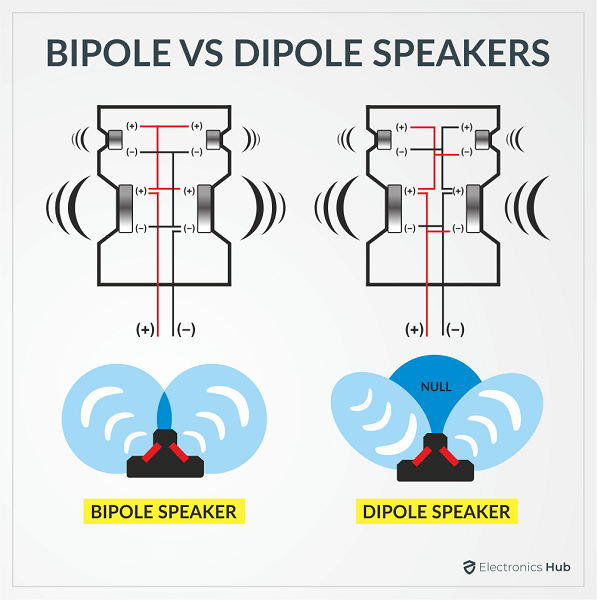Bipole Speakers
Bipole speakers have two drivers placed in a single encasement at an angle to each other. They are also considered bidirectional or in-phase speakers. They are constructed in a perfect phase with each other, radiating a wide sound field. A Bipolar speaker can be used as a front channel because of its good phase correlation because they are wired in phase with the opposite pair. Bipole speakers consist of two or more speakers, which output sound from both sides towards the front and the rear of the room. Both speakers work simultaneously. They produce a diffuse sound effect that can be placed in big rooms. They are not pinpointed and can be placed everywhere as they can deliver sound from anywhere. Bipole speakers are designed to produce an omnidirectional sound for a more room-filling music experience as it has both forward and rear-firing drivers. Both drivers push the air out at the same time. They are in phase with each other. They work well if they are not positioned exactly at the sides of the listener. As side surround speakers and rear speakers, they propel the sound in different directions therefore, the audio from these speakers is difficult to locate. Bipole speakers fire the sound to the seating area but not directly to the listener and in this way avoid hot spotting and provide a focused, direct surround sound, and at close range.
Dipole Speakers
A dipole speaker is the simplest speaker created by mounting one loudspeaker driver on one flat panel, and it is folded and occupies less space. It is called a dipole because it has two lobes and produces equal radiation forward and backward. It reduces the stimulation of the resonant room modes at lower frequencies. There are two speakers in a single enclosure that are wired out of phase that work together, such that only a single speaker produces sound at a time and forms a phase cancellation null at listening. This causes a sound to diffuse away from listening points. Phase cancellation produces an unexpected effect, such as losing bass frequencies. You might find that boosting bass frequencies do not cause any note-able effect. But this might feel lifelike in a small room filled with many seats when placed at the right spot. They are usually placed on side walls. One side pushes the air and one side pulls the air creating a dead zone at 90 degrees from the wall, which requires the listener to sit in a proper area. Simply, the dipole speaker produces the same amount of output from both the front and back of the speakers but is out of phase electrically. “Dipoles deliver a more expansive sense of ambiance” Dipole speakers produce less focused, diffused, and enveloping surrounding fields.
Bipole and Dipole Speakers-Difference
Both Bipole and dipole speakers are similar in a way, having two speakers in a single enclosure, but they are quite different because the drivers in Bipole speakers on both sides push air outwards at the same time. While in dipole speakers, the drivers are out phase with each other, that is one pulls, and one pushes the air. They do not work simultaneously. Bipole works when the speakers are not positioned to the sides of the listener exactly, while dipole requires being on the sides of the listener.
How Does a Surround Sound Speaker System Work?
For proper working of a surround speaker system we need:
A Media with audio mixed for surround sound. An audiovisual receiver And speakers are arranged around the sitting area.
In a surround sound speaker system, the listener requires two speakers either on the sides or behind him and two or three speakers facing him. The output sound splits up into multiple signals and each speaker produces a different sound with the most prominent sound coming from the front speakers. The power and connection with the audio hub are provided by a single wire to the speakers which are called wired surround sound speakers, and they are way better than wireless. Consider an example of a surround 5.1 system. It means 5 speakers and a subwoofer. Three of the five speakers in front of the listener are known as front speakers and the two on the sides are called surround left and surround right speakers. Adding two more speakers gets a 7.1 system and adding a subwoofer gets a 7.2 system. Adding a ceiling or height is also an option. In the surround system, the front speakers are the most critical ones. And if you have them, then it is easy to decide on surround speakers from three main types.
Choosing The Perfect Speaker?
The working of speakers relies upon the speaker’s place and the room’s acoustics. Place speakers in the right spot to avoid sound distortions that might be produced by reflection from the walls since this affects overall performance. Bipole is best for side or rear wall installation, and Dipole is for side wall installation. According to your need, a perfect speaker is decided. If you listen to a lot of music and can’t decide the place of the speaker, then a Bipole is for you. They produce excellent sound when placed on the rear wall and are excellent for home theatres.
Conclusion
From the above discussion, it is concluded that both are speakers and work well according to the condition of the area. The performance of the speakers depends on the placement and acoustics as they reduce or eliminate sound reflection coming from the walls of the room. Localization is also essential. “If the room is smaller, acoustically controlled, and there are many seats, a dipole will work better, and for small rooms and not acoustically controlled, Bipole are the best option.” Comment * Name * Email * Website
Δ






![]()